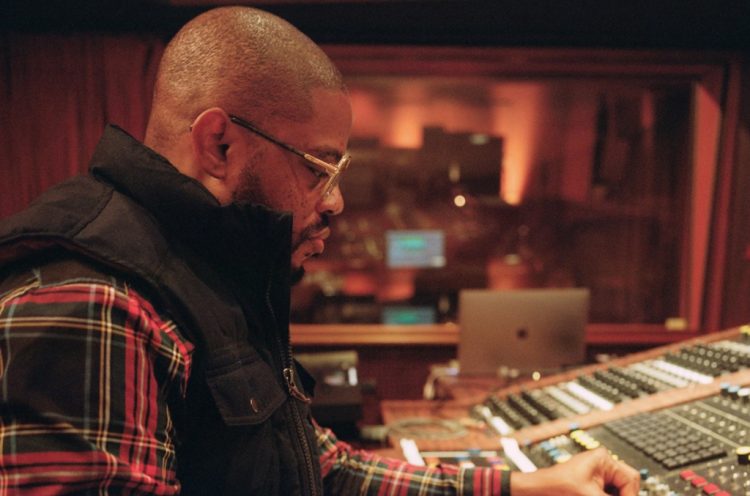Again in January at Los Angeles’ Gold Line, a Japanese-inspired vinyl bar run by Stones Throw Data, revered jazz drummer, hip-hop producer, songwriter and DJ Karriem Riggins, 47, is filming an interview for his new mini-documentary, Behind the Sleeves. The Native Devices-produced mini-doc in addition to its new NI Play Sequence instrument, “Karriem Riggins Drums,” are being launched immediately (Feb. 16).
For 3 many years, Karriem Riggins has been behind the scenes of many music followers’ favourite hip-hop information. His huge discography contains Kanye West’s The Lifetime of Pablo, Earl Sweatshirt’s I Don’t Like Shit, I Don’t Go Exterior, J Dilla’s Welcome 2 Detroit and Steve Lacy’s Gemini Rights, the newly minted Grammy winner for greatest progressive R&B album.
Behind the Sleeves not solely dissects Riggins’ life and profession by means of archival footage but in addition follows him round L.A. as he visits a few of music’s most historic websites. Amongst them: the aforementioned Gold Line, Sundown Sound’s Studio 3 (the place Prince lived and recorded) and J Dilla’s former house. Dilla, who handed away on Feb. 10, 2006, personally requested that Riggins assist full The Shining, the artist’s posthumous album launched later that yr.
“In my coronary heart, I don’t suppose he knew that he wasn’t going to be right here once we had been engaged on [the project],” says Riggins. “It was huge footwear to fill and large choices to make when J left me the message [about finishing the album]. Nevertheless it was a no brainer as a result of he’s one among my favourite individuals. I contemplate him a brother.”
The 2 initially met by means of Frequent in 1996 when Riggins was the bandleader of the Chicago rapper’s band, A Black Woman Named Becky. As fellow Detroit natives, Riggins and Dilla grew to become quick associates and frequent collaborators, teaming up for Dilla’s Welcome 2 Detroit and The Diary prematurely of The Shining.
After residing on each coasts for a majority of his profession, Riggins moved to Atlanta final August to be nearer to household and to expertise residing within the South for the primary time. The fixed by means of line for the drummer — who’s additionally collaborated with Erykah Badu, Denzel Curry and Daft Punk — has been to by no means stick to at least one area, one kind of artist or one style. What he cares about most is that whoever he’s working with possesses inventive imaginative and prescient, is open-minded and is in tune with their expertise — be it voice, musical instrument or digital audio.
“We give recommendations on what we predict may very well be dope,” says Riggins. “However these people who I’ve been blessed to work with make among the most good choices. It’s a collective factor.” That’s additionally one thing he realized from Dilla. “He informed me, ‘You should use what your expertise is and what you are able to do with [that] to attach the world,” Riggins remembers. “I really feel like I’m now lastly turning into the artist that I’m alleged to be.”
Riggins knew he needed to be a musician by the primary grade. The son of keyboardist Emmanuel Riggins, he grew up watching his father carry out with jazz greats like guitarist Grant Inexperienced and trumpeter Marcus Belgrave, with whom Riggins later studied trumpet and drums earlier than deciding to deal with the latter. Though Riggins obtained his begin producing hip-hop, he subsequently joined bands taking part in behind such influential jazz artists as Betty Carter, Roy Hargrove and Ray Brown. He’s additionally launched three solo albums of his personal: Alone Collectively, Headnod Suite and Pardon My French (as Jahari Massamba Unit with Madlib).
Riggins nonetheless continues to make use of his craft to show others. In partnership with Native Devices’ “Play Sequence” and painter Jason Jägel (who created the quilt artwork for MF DOOM’s 1999 album Operation: Doomsday), he created an interactive drum equipment to encourage younger music lovers.
“I hope this may spark one thing in people who have the expertise and the ear to leap into [producing] music,” he says. “I would like [the next generation of musicians] to be taught to be open and never stick to at least one factor. Music is music. Hearken to all the pieces; don’t field your self into one factor.”
As hip-hop celebrates its 50th anniversary, Riggins says that he desires “to maintain including one thing to the artwork type; one thing that folks have by no means heard earlier than. It’s the one style of music that’s nonetheless related and new, even with the affect of the previous. I simply wish to maintain taking part in hip-hop’s evolution.”




